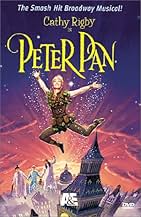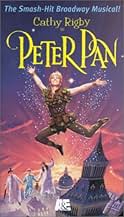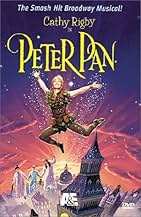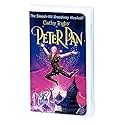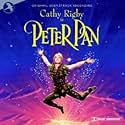Agrega una trama en tu idiomaThe fabled children's story show from Broadway produced for television.The fabled children's story show from Broadway produced for television.The fabled children's story show from Broadway produced for television.
- Dirección
- Guionistas
- Elenco
- Ganó 1 premio Primetime Emmy
- 1 premio ganado y 3 nominaciones en total
- Dirección
- Guionistas
- Todo el elenco y el equipo
- Producción, taquilla y más en IMDbPro
Opiniones destacadas
I only saw this production because I happened to find a VHS tape of it in a clearance rack in my local video store (and bought it for next-to-nothing). It is a new staging of the Broadway musical from the 1950's; this does not minimize its impact in any way, but there are many reviewers here who feel the need to make excessive (and in my opinion unfounded) comparisons between this production and the original one with Mary Martin- when, in fact, it is the same show. I have copies of both performances and primarily treasure the Martin production because of its historical significance as a time capsule of early television. This version with Olympic gymnast Cathy Rigby version is brilliant; its presentation differs from the 1960 one as they captured an actual performance from a theater with an audience rather than tape on a network sound stage. As someone else noted below, Ms. Rigby's mannerisms and costuming better are indeed more boyish than Ms. Martin's (although I didn't care for Ms. Rigby's attempt at a British accent). The point is they each do it a little differently, Ms. Rigby opting for more exuberance. The book itself is a bit corny (doesn't matter which version), but chances are you're watching it with your own children or re-living your own childhood- and that's sort of the point. The Act 1 finale which shows Peter and the Darling clan fly out the window is stunning. Plan to lose yourself for two hours, and you'll probably believe you can fly when it's over.
In Mary Martin's Peter Pan, the dances were very thrown together. This is not a bad thing when the cast can make it look like that is not the case. That WAS not the case. You could see mistake after mistake, and you could tell when even the littlest mistake was made.
Furthermore, the casting for Mary Martin's was terrible. Wendy had a piercing to the ear sounding voice, and Mary Martin in no way, shape, or form made a believable little boy. She instead made a believable little old man.
In Cathy's version, everyone sang on key, and everyone seemed prepared for the performance at hand. Cathy's performance made it easy to forget that she was an adult woman, and truly made you believe that she was that of a young boy. This is not easy for many actors/actresses out there. What's funny is that she had little training. Mary Martin had lots.
Makes you wonder who possessed the real talent.
Furthermore, the casting for Mary Martin's was terrible. Wendy had a piercing to the ear sounding voice, and Mary Martin in no way, shape, or form made a believable little boy. She instead made a believable little old man.
In Cathy's version, everyone sang on key, and everyone seemed prepared for the performance at hand. Cathy's performance made it easy to forget that she was an adult woman, and truly made you believe that she was that of a young boy. This is not easy for many actors/actresses out there. What's funny is that she had little training. Mary Martin had lots.
Makes you wonder who possessed the real talent.
I have seen both the Mary Martin version and this version, and even though I have fond memories of watching the Mary Martin version when I was younger, I enjoyed this one a lot more. The Mary Martin version was excellent, don't get me wrong, but while watching it, you consciously think to yourself,"This is a woman playing a little boy." In many ways, this can ruin the experience. In the Cathy Rigby version, Rigby acts as a little boy would. She uses the gestures a boy would, she moves as a boy would, and when delivering her lines and singing you actually believe that she is a little boy that just did not want to grow up. Elisa Sagardia was also wonderfully enchanting in her role as Wendy. When watching it you feel as if Wendy is your own sister or mother. Everything is an improvement from the Mary Martin version-the pirates are animated and hilarious, the lost boys are also quite funny and child-like, the Indians have wonderful dance sequences and you almost feel hypnotized while watching them. I suppose it is a matter of taste and what appeals to you more-charming, quaint, heart-warming productions, or believable, spectacular, animated, eye-catching, mind boggling, rhythmic, hypnotic productions. Out of 10 stars, I give it a solid 7 1/2.
Yes, the production is lavish. But the performance is wonderful! Cathy Rigby comes across as a real boy: innocently cruel and noble in equal measure. Most kid's fairy tales are rather um, grim -- and this one is no exception.
Okay, so just a week ago I saw this version all the way through for the first time (and now I've seen it 3 times). This is, of course, after having seen 3 other versions of the same story of Peter and Wendy (Mary Martin version of the play, the Disney version which really sucks because it is so inaccurate, and the new live-action version). The one advantage I think I had with this version was that I've read the book (twice now) before seeing it. (I actually just finished reading it the second time today.)
So what do I think of this version? It is very unique in that it incorporates different aspects that are captured in the book but not in any other version I've seen. Such as Peter's "shortish" name, Wendy calling Peter ignorant, Peter's outright unquestionable "in charge" attitude toward the boys, and probably the most important aspect--the dark and dangerous perspective of Neverland itself.
Someone said in another comment that this version made Neverland out to be scary, and to be quite frank, it can be a scary place. Let's think about this, shall we? Neverland is the compilation of all imaginary playlands of children (according to the book), and (correct me if I'm wrong) many children find danger and darkness to be exciting. Don't boys sometimes imagine playing in misty dark waters with real danger lurking nearby? As Sir JM Barrie said himself, "In the old days at home the Neverland had always begun to look a little dark and threatening by bedtime. Then unexplored patches arose in it and spread; black shadows moved about in them; the roar of beasts of prey was quite different now, and above all, you lost the certainty that you could win. You were quite glad that the night-lights were on. You even liked Nana to say that this was just the mantelpiece over here, and that the Neverland was all make-believe. Of course the Neverland had been make-believe in those days; but it was real now, and there were no night-lights, and it was getting darker every moment, and where was Nana?" (Peter Pan, Chapter 4 "The Flight") Obviously Neverland could be a dark and dangerous place.
Also, along the same lines, it has been said that the jokes don't seem to fit or something like that. I must say that I found the jokes quite entertaining and they fit quite well. They keep with the playful and childish attitude that the play should be taken with. Are grown-ups so de-sensitized by modern comedy that they cannot even find a little humor in what two or more children say to offend each other? Or even the usual banter, during a play, between the villain and audience?
Even Peter's overall cockiness is refreshing. Barrie said himself, "It is humiliating to have to confess that this conceit of Peter was one of his most fascinating qualities. To put it with brutal frankness, there never was a cockier boy." (Peter Pan, Chapter 3 "Come Away, Come Away") And Cathy Rigby kept that cockiness in Peter throughout the play.
I must also say that I was very impressed with the emotional turmoil that Peter is shown going through. Cathy Rigby does a wonderful job at portraying the pain that Peter is feeling at Wendy's leaving Neverland and about remembering how his mother had closed the window. And in the end, the anguish of finding Wendy grown up makes you want to hug Peter and tell him it's all right.
And I'm surprised no one has mentioned Smee really. In this version he truly is lovable, just as Barrie described him. I found him very amusing, especially at the end when he returns with the Lost Boys to the Darling nursery (even if that wasn't really part of the story, it was still humorous and forgivable).
The Indians, I think, gave an extra flare that was lacking in especially the Mary Martin version. Here we find the Indians actually acting like Indians instead of random people dressed in loose Indian shirts and pants. Whether the actors were true Indians in this version (which I highly doubt they were) they were much more believable and menacing, just as in the book.
All in all, this version is very very close to the book itself, which I think is a great thing, as I am a stickler for accuracy in storytelling.
Don't get me wrong, though. I grew up (literally) with the Mary Martin version and I will always have a special place in my heart for it, even if it is a bit cheesy on the acting and sets. I love the music in both versions equally (since they are pretty much the same), but sometimes I wonder... would the real Peter Pan break out into a catchy song about Neverland and about never growing up? Hmm... I wonder.
So what do I think of this version? It is very unique in that it incorporates different aspects that are captured in the book but not in any other version I've seen. Such as Peter's "shortish" name, Wendy calling Peter ignorant, Peter's outright unquestionable "in charge" attitude toward the boys, and probably the most important aspect--the dark and dangerous perspective of Neverland itself.
Someone said in another comment that this version made Neverland out to be scary, and to be quite frank, it can be a scary place. Let's think about this, shall we? Neverland is the compilation of all imaginary playlands of children (according to the book), and (correct me if I'm wrong) many children find danger and darkness to be exciting. Don't boys sometimes imagine playing in misty dark waters with real danger lurking nearby? As Sir JM Barrie said himself, "In the old days at home the Neverland had always begun to look a little dark and threatening by bedtime. Then unexplored patches arose in it and spread; black shadows moved about in them; the roar of beasts of prey was quite different now, and above all, you lost the certainty that you could win. You were quite glad that the night-lights were on. You even liked Nana to say that this was just the mantelpiece over here, and that the Neverland was all make-believe. Of course the Neverland had been make-believe in those days; but it was real now, and there were no night-lights, and it was getting darker every moment, and where was Nana?" (Peter Pan, Chapter 4 "The Flight") Obviously Neverland could be a dark and dangerous place.
Also, along the same lines, it has been said that the jokes don't seem to fit or something like that. I must say that I found the jokes quite entertaining and they fit quite well. They keep with the playful and childish attitude that the play should be taken with. Are grown-ups so de-sensitized by modern comedy that they cannot even find a little humor in what two or more children say to offend each other? Or even the usual banter, during a play, between the villain and audience?
Even Peter's overall cockiness is refreshing. Barrie said himself, "It is humiliating to have to confess that this conceit of Peter was one of his most fascinating qualities. To put it with brutal frankness, there never was a cockier boy." (Peter Pan, Chapter 3 "Come Away, Come Away") And Cathy Rigby kept that cockiness in Peter throughout the play.
I must also say that I was very impressed with the emotional turmoil that Peter is shown going through. Cathy Rigby does a wonderful job at portraying the pain that Peter is feeling at Wendy's leaving Neverland and about remembering how his mother had closed the window. And in the end, the anguish of finding Wendy grown up makes you want to hug Peter and tell him it's all right.
And I'm surprised no one has mentioned Smee really. In this version he truly is lovable, just as Barrie described him. I found him very amusing, especially at the end when he returns with the Lost Boys to the Darling nursery (even if that wasn't really part of the story, it was still humorous and forgivable).
The Indians, I think, gave an extra flare that was lacking in especially the Mary Martin version. Here we find the Indians actually acting like Indians instead of random people dressed in loose Indian shirts and pants. Whether the actors were true Indians in this version (which I highly doubt they were) they were much more believable and menacing, just as in the book.
All in all, this version is very very close to the book itself, which I think is a great thing, as I am a stickler for accuracy in storytelling.
Don't get me wrong, though. I grew up (literally) with the Mary Martin version and I will always have a special place in my heart for it, even if it is a bit cheesy on the acting and sets. I love the music in both versions equally (since they are pretty much the same), but sometimes I wonder... would the real Peter Pan break out into a catchy song about Neverland and about never growing up? Hmm... I wonder.
¿Sabías que…?
- TriviaThe characters of Nana, Jane, and a Mermaid were all played by Cathy Rigby's children: Thomas Buck Mason, Theresa McCoy, and Kaitlin McCoy.
- Citas
Peter Pan: You musn't touch me! No one has ever touched me!
Wendy Moira Angela Darling: Why not?
Peter Pan: ...I don't know.
- ConexionesReferenced in El Cascanueces 3D (2010)
Selecciones populares
Inicia sesión para calificar y agrega a la lista de videos para obtener recomendaciones personalizadas
Detalles
- Tiempo de ejecución1 hora 45 minutos
- Color
Contribuir a esta página
Sugiere una edición o agrega el contenido que falta

Principales brechas de datos
By what name was Peter Pan (2000) officially released in Canada in English?
Responda

